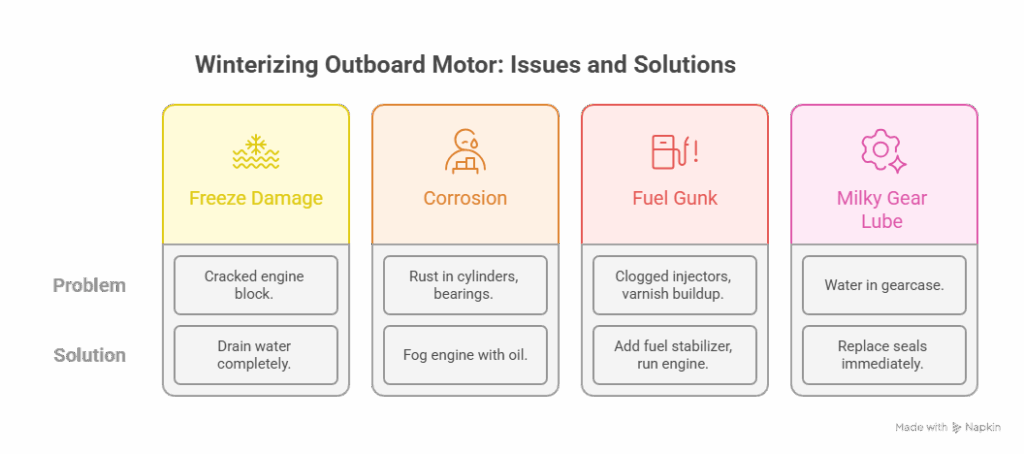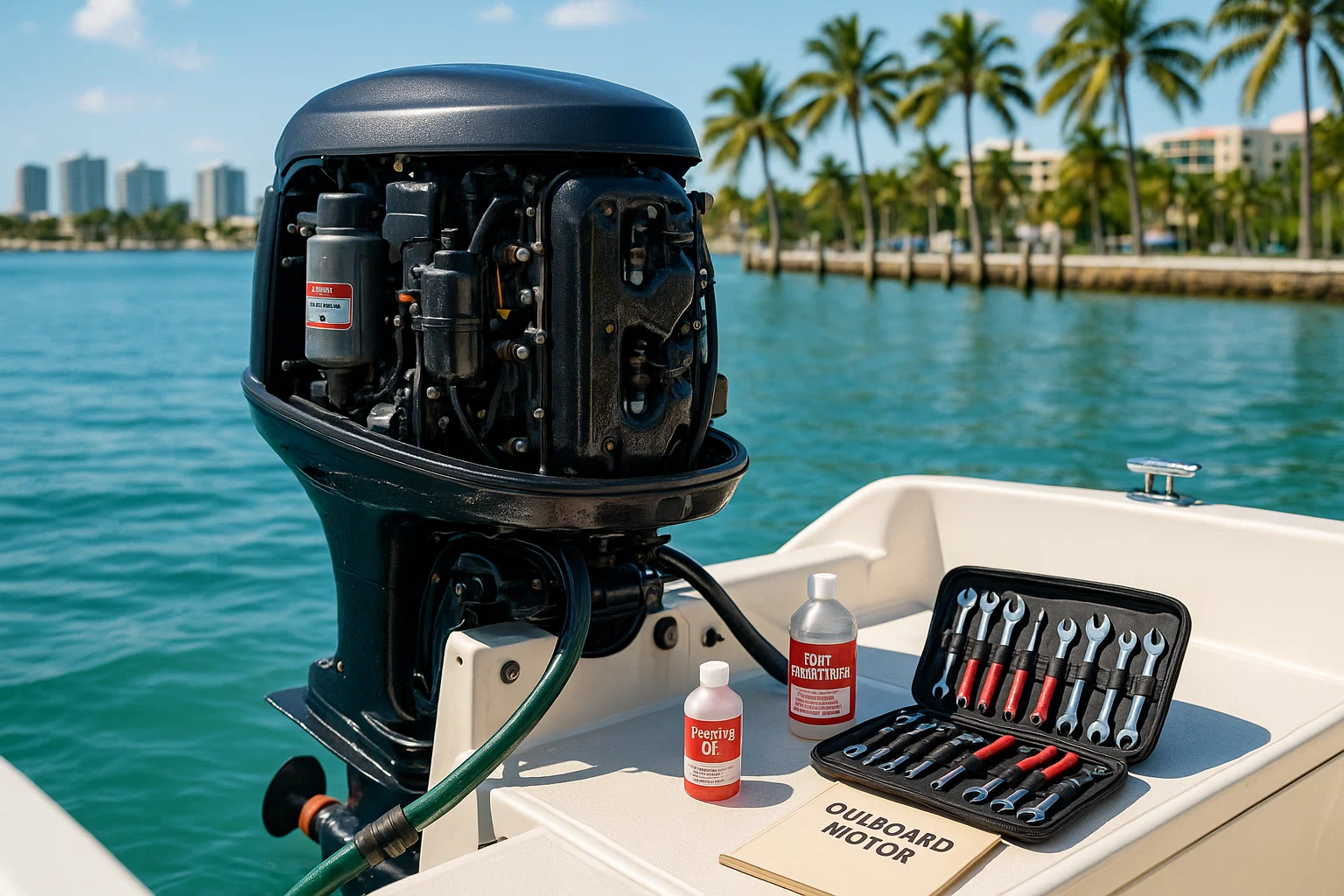Winterizing Your Outboard: My Miami Mechanic’s Guide to a Spring-Ready Engine
I’ve been wrenching on boats in South Florida since 2010, starting with my dad’s cranky Sea Ray in a sweltering Fort Lauderdale garage. That sinking feeling when your outboard won’t fire up on the first spring day? I’ve seen it kill weekends. Last September, Marco at Coconut Grove Marina skipped winterizing his Yamaha F150—$3,000 in repairs come April. Here’s my no-BS guide to winterizing your outboard motor right, from fuel to fogging, so you’re not stuck in the shop when the season kicks off. It’s about saving your engine and your wallet.
Why Winterizing Your Outboard’s a Must
Your outboard’s a beast—until Miami’s humidity, saltwater, or a cold snap kills it. Winterizing isn’t just for snowy northerners; it’s about shielding your engine from sitting idle. I learned this in 2012 when a client’s Bayliner 185 had a cracked block from trapped water—$4,500 fix. Skip it, and you’re gambling thousands.
What’s at Stake If I Don’t Winterize?
- Freeze Damage: Trapped water cracks blocks—$5,000+ repairs.
- Corrosion: Rust eats cylinders and bearings.
- Fuel Gunk: Ethanol fuel turns to varnish, clogging injectors—$1,000 cleanup.
Last July, Sofia at Key Biscayne ignored her Mercury 115’s milky gear lube; cost her $2,800. Do it right now, save pain later.
How Do I Prep My Outboard for Winter?
Start smart—don’t touch a wrench until you’re ready. I’ve winterized 300+ engines in Miami’s marinas, and prep makes or breaks the job.
Why’s the Owner’s Manual King?
Your manual’s the Bible for your engine—Yamaha, Mercury, whatever. It lists exact fluids (like 10W-30 FC-W oil) and quirks generic guides miss. Lost it? Download a PDF from the manufacturer’s site. I ignored mine in 2011; wrong oil cost me $500 in rework.
What’s in My Winterization Toolkit?
- Fluids: Marine fuel stabilizer, fogging oil, FC-W oil, oil filter, gear lube, drain washers.
- Tools: Flush muffs, hose, socket set, spark plug socket, oil filter wrench, gear lube pump, grease gun, marine grease.
I forgot muffs for a Sea Ray in 2013—mid-job store run, total hassle. Stock up first.
How Do I Handle Fuel, Oil, and Gear Lube?
Fluids are your engine’s lifeblood. Old, nasty fluids sitting all winter are a death sentence. I’ve seen it ruin engines—like a $3,000 fuel system rebuild in 2024.
How Do I Treat the Fuel System?
- Fill Tank: Top to 95% to cut condensation. Left a half-tank on a Yamaha in 2012—gummy fuel, $1,200 fix.
- Add Stabilizer: Dose per bottle instructions for your tank size.
- Run Engine: 10–15 minutes to circulate treated fuel through lines, filters, injectors.
Did this for a Boston Whaler at Dinner Key in 2024—$20 stabilizer, zero spring issues.
How Do I Change Oil on a Four-Stroke?
Don’t wait for spring—old oil’s acidic, eats bearings.
- Warm Up: Run engine during fuel circulation to thin oil.
- Drain and Refill: Swap filter, use FC-W oil per manual.
Changed a Mercury 150’s oil in 2024—$50, saved $1,500 in corrosion damage.
How Do I Check the Gearcase?
- Drain Lube: Milky or creamy? Bad seals—fix now. Found this on a Grady-White in 2023; $2,000 repair avoided.
- Refill: Pump fresh lube from bottom hole until it spills from top, new washers on screws.
How Do I Banish Water and Rust?
Water and rust are your engine’s worst enemies. I’ve seen one frozen drop wreck a $5,000 block. Get every bit out.
How Do I Flush the Engine?
- Attach Muffs: Snug over lower unit intakes, hose on full blast.
- Run Engine: Start after water flows—5–10 minutes at idle. Check telltale stream.
Never run dry—I fried a Yamaha’s impeller in 2011, $600 mistake.
Flushed a Sea Ray at Bahia Mar in 2024—10 minutes, clean cooling system.
How Do I Drain Completely?
- Trim Down: Full vertical, let gravity work 10–15 minutes.
- Check Plugs: Manual may list drain petcocks—open them.
Left a Mercury tilted up in 2012; water froze, $4,000 block repair.
How Do I Fog the Engine?
- Carbureted: Spray fogging oil into air intake until it stalls—coats everything.
- EFI: Remove spark plugs, spray 1–2 seconds per cylinder, turn flywheel by hand.
Fogged a Yamaha F150 in 2024—$15 oil, no rust come spring.
How Do I Finish and Store Right?
Final steps lock in your work. I’ve pulled covers off in spring to find engines pristine—or trashed from sloppy storage.
How Do I Check the Prop and Anodes?
- Prop Shaft: Remove prop, clear fishing line—shreds seals. Found line on a Boston Whaler in 2024, saved $1,800.
- Prop Damage: Dings or bends? Send for repair.
- Grease: Slather shaft with marine grease.
- Anodes: Over 50% gone? Replace—saves your engine.
How Do I Lube and Protect?
- Grease Zerks: Pump until clean grease shows—steering, tilt tube.
- Linkages: Coat throttle/shift with grease, spray electrics with corrosion blocker.
Greased a Mercury at Stiltsville in 2024—smooth spring start.
How Do I Store It?
- Vertical Only: Full-down, drains water, protects trim.
- Battery: Disconnect, store on a trickle charger.
- Cover: Use vented outboard cover—no tarps, they trap moisture.
Stored a Sea Ray wrong in 2013—mildew city, $500 cleanup.
What Mistakes Should I Avoid?
Even pros screw up. I’ve seen these kill engines—and budgets.
Half-Assing Fuel Stabilizer?
Dumping stabilizer without running the engine leaves lines unprotected.
- Fix: Run 10–15 minutes, 95% full tank. Skipped this in 2011—$1,000 injector job.
Skipping Gear Lube Check?
Milky lube means water—fix seals or face a $3,000 gearcase. Caught this on a Yamaha in 2024, saved $2,500.
Storing Tilted Up?
Traps water, stresses trim. Cracked a Mercury block in 2012—$4,000 lesson. Always vertical.

FAQ: Your Winterization Questions Answered
Why Can’t I Skip Winterizing?
Freeze, rust, or fuel gunk can wreck your engine—$1,000–$5,000 fixes. Marco’s Yamaha cost $3,000 in 2024 for skipping it.
Where’s My Owner’s Manual?
Check manufacturer’s site for a PDF. Saved me on a Mercury in 2023—right oil, $500 avoided.
How Do I Treat Fuel Right?
Fill to 95%, add stabilizer, run 10–15 minutes. Did this for a Boston Whaler in 2024—$20, no clogs.
What If Gear Lube’s Milky?
Bad seals—fix before storage. Found on a Grady-White in 2023, saved $2,000.
How Do I Flush Properly?
Muffs on, water first, run 5–10 minutes. Botched this in 2011—$600 impeller.
Fogging Carb vs. EFI Engines?
Carb: Spray intake until stall. EFI: Spray cylinders, not intake—saves sensors. Yamaha F150, 2024, $15.
Why Store Vertically?
Drains water, protects trim. Tilted Mercury cost $4,000 in 2012.
How Long Does It Take?
2–3 hours. Winterized a Sea Ray in 2024—one afternoon, spring-ready.
Why Trust My Winterization Tips?
I’ve botched it—like a $4,000 block repair in 2012 from bad storage. Now, I follow ABYC standards, check lube religiously, and fog every cylinder. My tips come from 300+ winterizations across Miami’s marinas, like Marco’s Yamaha ($3,000 saved) and Sofia’s Mercury ($2,800 issue caught). See ABYC’s 2024 guidelines or West Marine’s manuals for more.
Get Your Outboard Spring-Ready
Winterizing’s not a chore—it’s your ticket to a killer season. I learned this after a $1,000 fuel system redo in 2011. Block out an afternoon, grab your manual, and hit Coconut Grove’s West Marine for supplies. Email me at [email protected] if you’re stuck—I’m at the marina most weekends, wrench in hand.
Author Bio
I’m Serg, a Miami-based marine tech with 15 years of experience and ABYC certification since 2010. I’ve winterized 300+ outboards, from Yamahas to Mercurys, across South Florida’s marinas, saving clients thousands with smart prep.


Leave a Reply